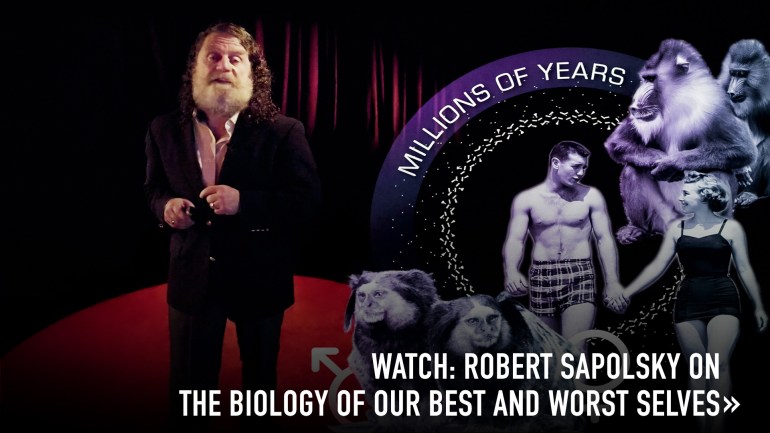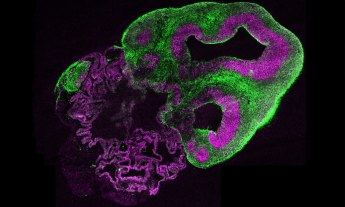
Neuroscientist Robert Sapolsky shows us the surprising ways that our brains get mixed up between the physical and metaphorical — and how this can pit us against each other.
When humans put pigment to wall in Lascaux Cave more than 17,000 years ago, the point was to minimize the distance between object and representation, to be as close as possible to possessing the real horse. To gain its power, as imbued in a symbol.
The clearest human mastery of symbolism comes with our use of language. Suppose you are being menaced by something and thus scream your head off. Someone listening can’t tell if it’s in response to a suicide bomber or Komodo dragon. Most animal communication is about such present-tense emotionality.
Symbolic language brought huge evolutionary advantages. This can be seen even in the starts of symbolism of other species. When vervet monkeys, for instance, spot a predator, they don’t generically scream. They use distinct vocalizations, different “protowords,” where one means “Predator on the ground, run up the tree!” and another means “Predator in the air, run down the tree!” Evolving the cognitive capacity to make that distinction is useful, as it prompts you to run away from danger. Language pries apart a message from its meaning, and as our ancestors improved at this separation, their advantages accrued.
Our brains are winging it and improvising on the fly when dealing with metaphor.
The height of the symbolic features of language is our use of metaphor. Metaphors are everywhere in language — we may literally and physically be “in” a room, but we are only metaphorically inside something when we are “in” a good mood, “in” cahoots with someone or “in” love. We understand that a captain wants more than just hands when ordering all of them on deck, and that June doesn’t really bust out all over. These capacities evolved so recently that our brains are, if you will, winging it and improvising on the fly when dealing with metaphor. As a result, we are pretty lousy at distinguishing between the metaphorical and literal, at remembering that “it’s only a figure of speech” — with enormous consequences for our best and worst behaviors.
If humans (or any other mammal) bite into rancid food, the insular cortex lights up and processes gustatory disgust, causing us to spit it out, gag, feel nauseated, make a revolted facial expression. Ditto for revolting smells. We wrinkle our nose, raise our upper lip, narrow our eyes. All of this behavior is intended to protect us from toxins and infectious pathogens.
As humans we do some fancier things. When we think about rancid food, the insula activates; when we look at faces showing disgust, the same occurs. Most important, if you think about a truly reprehensible act, the same occurs. The insula mediates visceral responses to norm violations; the more activation, the more condemnation. This is visceral, not just metaphorically visceral. When I heard about the Sandy Hook Elementary School massacre, “feeling sick to my stomach” wasn’t a mere figure of speech. When I imagined the reality of the murder of 20 first-graders and the six adults protecting them, I felt nauseous. The insula not only prompts the stomach to purge itself of toxic food, it also prompts the stomach to purge the reality of a nightmarish event. The distance between the symbolic message and the meaning disappears.
Hearing about virtuous moral acts makes drinks taste better.
This linking of visceral and moral disgust is bi-directional. As shown in a number of studies, contemplating a morally disgusting act leaves more than a metaphorical bad taste in your mouth — people eat less immediately afterward, and a neutral-tasting beverage drunk afterward is rated as having a more negative taste (conversely, hearing about virtuous moral acts made the drink taste better).
The physiological core of gustatory disgust is to protect yourself against pathogens. The core of the intermixing of visceral and moral disgust is a sense of threat as well. A socially conservative stance about, say, gay marriage is not just that it is simply wrong in an abstract sense, but that it constitutes a threat — to the sanctity of marriage and family values.
This element of threat is shown in a great study in which subjects either did or didn’t read an article about the health risks of airborne bacteria. All then read a history article that used imagery of America as a living organism, with statements like “Following the Civil War, the United States underwent a growth spurt.” Those who read about scary bacteria before thinking about the US as an organism were then more likely to express negative views about immigration (without changing attitudes about an economic issue).
First you’re disgusted by how Others smell, a gateway to then being disgusted by how Others think.
My guess is that people with a stereotypically conservative exclusionary stance about immigration rarely have the sense that they feel disgusted that people elsewhere in the world would want to come to the United States for better lives. Instead, there is threat by the rabble, the unwashed masses, to the American way of life. How cerebral is this intertwining of visceral and moral disgust? Does the insula get involved in moral disgust only if it’s of a particularly gruesome nature — blood and guts, body parts?
It is clear that the intertwining of visceral and moral disgust is, at the least, greatest when the latter taps into core disgust. To repeat a neat quote from psychology professor Paul Rozin, “Disgust serves as an ethnic or out-group marker.” First you’re disgusted by how Others smell, a gateway to then being disgusted by how Others think.
Literal cleanliness and orderliness can release us from abstract cognitive and affective distress — just consider how, during moments where life seems to be spiraling out of control, it can be calming to organize your clothes, clean the living room, get the car washed. The ability of literal cleanliness to alter cognition was shown in one study. Subjects examined an array of music CDs, picked 10 that they liked, and ranked them in order of liking. They were then offered a free copy of one of their midrange choices (number five or six). Subjects were then distracted with some other task and then asked to re-rank the ten CDs. They showed a common psychological phenomenon, which was to now overvalue the CD they’d been given, ranking it higher on the list than before. Unless they had just washed their hands (ostensibly to try a new brand of soap), in which case no re-ranking occurred. Clean hands, clean slate.
We intertwine physical and moral purity when it comes to our own actions. In one of my all-time favorite psychology studies, Chen-Bo Zhong of the University of Toronto and Katie Liljenquist of Northwestern University demonstrated that the brain has trouble distinguishing between being a dirty scoundrel and being in need of a bath. Subjects were asked to recount either a moral or an immoral act in their past. Afterward, as a token of appreciation, the researchers offered the volunteers a choice between the gift of a pencil and a package of antiseptic wipes. The folks who had just wallowed in their ethical failures were more likely to go for the wipes. Another study, showing the same effect when people were instructed to lie, demonstrated that the more adversely consequential the lie was presented as being, the more washing subjects did. Lady Macbeth and Pontius Pilate weren’t the only ones to at least try to absolve their sins by washing their hands, and this phenomenon of embodied cognition is referred to as the “Macbeth effect.”
In one study, liars were more likely to pick complimentary cleansing products than subjects who were truthful.
This effect is remarkably concrete. In another study, subjects were instructed to lie about something — with either their mouths (i.e., to tell a lie) or their hands (i.e., to write down a lie). Afterward, remarkably, liars were more likely to pick complimentary cleansing products than control subjects who communicated something truthful: the immoral mouthers were more likely to pick a mouthwash sample; the immoral scribes, hand soap. Furthermore, as shown with neuroimaging, when contemplating mouthwash versus soap, those who’d just spoken a lie activated parts of the sensorimotor cortex related to the mouth (i.e., the subjects were more aware of their mouths at the time); those who had written the lie activated the cortical regions mapping onto their hand.
Another fascinating study showed the influence of culture in the Macbeth effect. The studies previously cited were carried out with European or American subjects. When the same is done with East Asian subjects, the urge afterward is to wash the face, rather than the hands. If you are going to save face, it should be a clean one.
Finally, this intermixing of moral and physical hygiene affects the way we actually behave. That original study on contemplating one’s moral failings and the subsequent desire to wash hands included a second experiment. As before, subjects were told to recall an immoral act of theirs. Afterward subjects either did or didn’t have the opportunity to clean their hands. Those who were able to wash were less likely to respond to a subsequent (experimentally staged) request for help. In another study, merely watching someone else wash their hands in this situation (versus watching them type) also decreased helpfulness afterward (although to a lesser extent than the subject washing). Many of our moments of prosociality, of altruism and Good Samaritanism, are acts of restitution, attempts to counter our antisocial moments. What these studies show is that if those metaphorically dirtied hands have been unmetaphorically washed in the interim, they’re less likely to reach out to try to balance the scales.
Our brains’ confusion of the metaphorical with the literal literally matters. We know that there is an array of mechanisms used by various species for recognizing kin and degree of relatedness — e.g., genetically shaped pheromonal signatures and imprinting on the female whose birdsong you heard a lot while you were still inside an egg. And we’ve seen among other primates there are cognitive components as well. For instance, male baboons’ degree of paternalism can be predicted by their likelihood of being the father.
By the time we get to humans, the process is mostly cognitive. We can think our way to deciding who is a relative, who is an Us. And thus, we can be manipulated into thinking that some individuals are more related to us, and others less so, than they actually are — there are numerous ways to get someone to think that an Other is so different they barely count as human. But as propagandists and ideologues have long known, if you want to get someone to feel that an Other hardly counts as human, there is only one way to do it: engage the insula. And the surest way to do that is with metaphor.
Excerpted from the new book Behave: The Biology of Humans at Our Best and Worst by Robert Sapolsky. Reprinted with permission from Penguin Press, a division of Penguin Random House LLC. © 2017 Robert Sapolsky.













